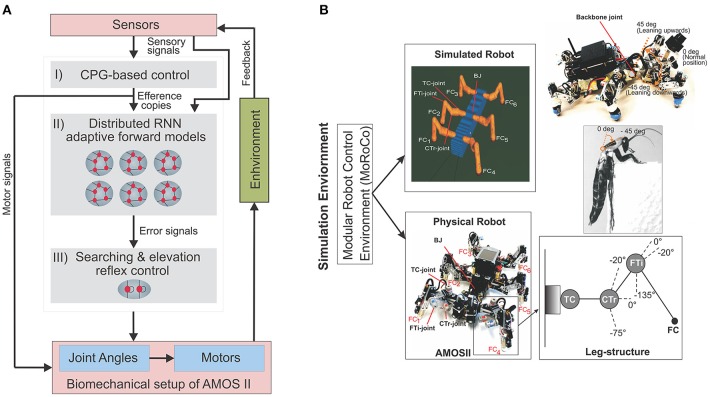Figure 1.
(A) The closed-loop architectural diagram of an artificial bio-inspired walking system consisting of the sensors (i.e., proprioceptive and exteroceptive sensors) that receive environmental inputs and feedback, the neural mechanisms (i, ii, iii) for adaptive locmotion control, and the biomechanical setup of the hexapod robot AMOSII [i.e., six 3-jointed legs, a segmented body structure with one active backbone joint (BJ), actuators, and passive compliant components Manoonpong et al., 2013]. (B) Modular Robot Control Environment embedded in the LPZRobots simulation toolkit (Der and Martius, 2012; Hesse et al., 2012). (Top left) The simulation environment provides the main testbed for developing the controller, testing it on the simulated hexapod robot, and finally transferring it to the physical agent. Here we evaluate our model and results primarily on the simulated robot (bottom left), which accurately embodies the characteristics of its physical equivalent, AMOS II robot (bottom left). Here, FC1, FC2, FC3, FC4, FC5, and FC6 are foot contact sensors installed in the robot legs, which are used as the main sensory stimuli compared against the predicted signal from the RNN-based (reservoir) forward models. Each leg (bottom right inset) consists of three joints: the innermost thoraco-coxal (TC-) joint enables forward and backward movements, the middle coxa-trochanteral (CTr-) joint enables elevation and depression of the leg, and the outermost femur-tibia (FTi-) joint enables extension and flexion of the tibia. The morphology of these multi-jointed legs were designed based on a cockroach leg (Zill et al., 2004). (Top right) The front and back parts of the body are connected with a backbone joint (BJ) which primarily allows upwards and downwards tilting of the front body segment (along the horizontal axis). Thus, this is used for climbing and gap crossing purposes. This is also based on a similar joint structure found in the cockroach morphology, allowing it to climb large obstacles. More details on BJ control for climbing can be found in Goldschmidt et al. (2014).

